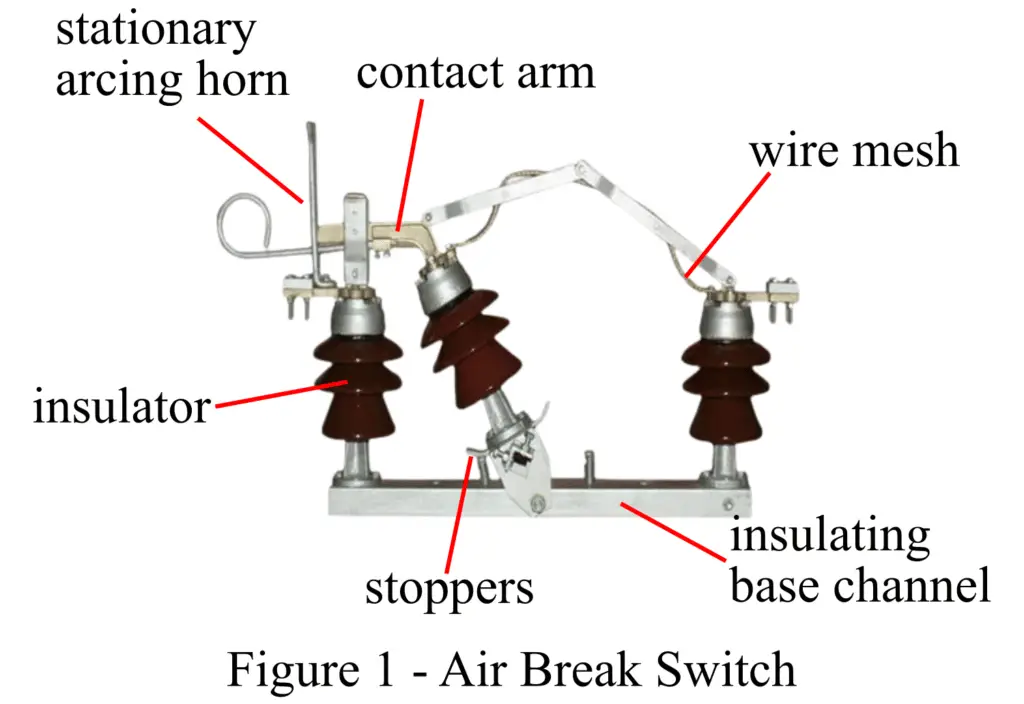In this article, we will discuss a type of switchgear called an air break switch, its types, and applications in the electrical industry. Let us start with the basic introduction to the air break switch.
What is Air Break Switch?
Air Break Switch (ABS) is a type of switchgear equipment used in electrical power switching applications. It is called an air break switch because it makes use of air as the dielectric medium to suppress the electric arc produced during the closing and opening of the switch.
Air break switches are extensively used in electrical distribution networks for switching and isolation purposes of distribution lines. They can be used for both switching and isolation. Air break switches are generally used in outdoor installations, and are usually operated with the help of a handle provided at the ground level. Although, the operation of the air break switch may also be automated by connecting an electric motor, after that they can be operated remotely.
As mentioned earlier, the air break switch uses compressed air to quench the arc produced while opening its contacts. Hence, they are cheaper than other types of switches. Air brake switches are generally designed for voltage levels up to 33 kV, and current levels up to 10 kA.
Types of Air Break Switch
The air break switches are classified into two types namely,
- Single-Pole Air Break Switch – Single pole air break switch is used for isolating only a single line conductor. It is operated by using a handle provided at the ground level.
- Gang-Operated Air Break Switch – When an air break switch is designed to open more than one conductor at a time, then it is called a gang-operated air break switch. In the case of a gang-operated air break switch, more than one switch is opened or closed together by a single handle.
Installation of Air Break Switches
Air break switches can be installed in two ways – Horizontally and Vertically. These are usually installed either in pole-top or mid-pole configuration.
Construction and Working of Air Break Switch
The construction of a typical air beak switch is shown in figure-1.

An air break switch consists of several parts such as an insulating base channel, stoppers, wire mesh, contact arm, stationary arcing horn, insulators, etc.
These switches are generally used to open the electric circuit under load conditions. The arc produced during the switching process is quenched by compressed air. In most air break switches, the arc produced is quenched either by moving contacts far away from each other or by supplying an interruption. Thus, the arc produced is extinguished by increasing the length of arcing horns present in the switch structure. The arcing horns are the metal pieces between which the arc is created. When the switch gets opened, the arcs tend to move away from each other, and ultimately break out.
Advantages of Air Break Switch
The important advantages of an air break switch are listed below:
- Air break switches are comparatively more efficient and consistent.
- They can be operated manually as well as remotely.
- It requires less maintenance.
- They are less expensive.
- Air break switches can do fast switching and breaking.
- There are no fire and explosion hazards in the case of air break switches.
Disadvantages of Air Break Switch
The major disadvantages of air break switch are given below:
- The air break switch is heavier in weight.
- These switches are not suitable for modern power systems.
- These switches have poor arc quenching properties due to air used as a dielectric medium.
- In the air break switch, there is a change of air leakage that can cause reduced air pressure.
Applications of Air Break Switch
The applications of air break switches are listed as follows:
- Air break switches are used in distribution networks.
- They are mainly used in outdoor installations for switching.
- These switches are used to interrupt excitation currents and capacitive charge current in transmission lines.
- They are also used in electric power generation lines.
- These switches are also used to isolate a part of the overhead line without influencing the rest part of the transmission and distribution system, etc.
- These types of switches are widely used to perform ON/OFF switching by simply connecting the overhead line’s power system to the main distribution line otherwise by separating it from the major distribution line.
- The switches are connected to overhead power transmission lines.
- Very useful for isolation & switching purposes
- These types of switches are used in industrial plants for different safety & control operations.
Hence, this is all about the air break switch, its construction, working, types, advantages, and applications.
It’s a good research keep it up.